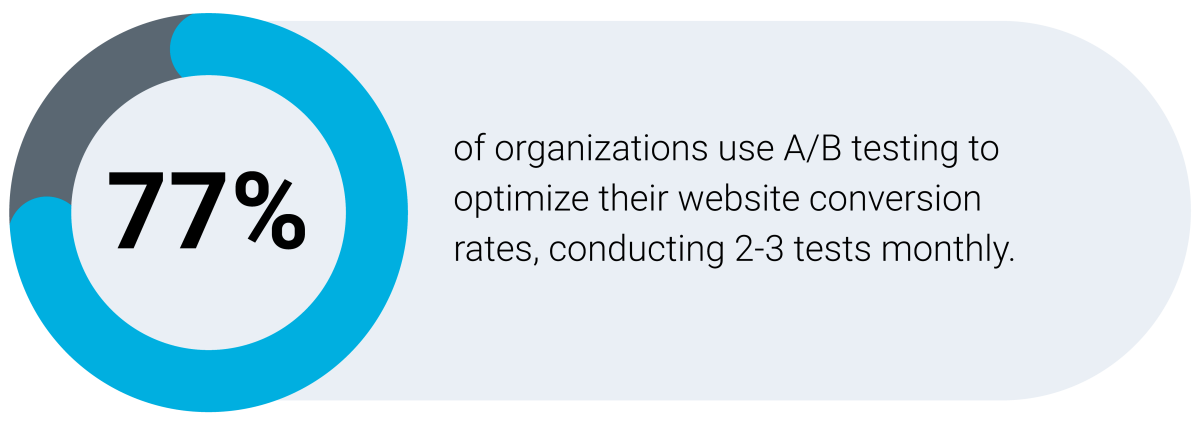Investing significant time and effort into creating what you believe is perfect content only to see it fall short with your audience can be disheartening. Fortunately, there’s a method to enhance your chances of success and ensure your content resonates with decision-makers in your target audience—enter the best A/B testing resources. This potent tool allows you to test different content versions, increasing engagement conversions and optimizing the success of your content distribution. This article explores the significance of testing in content distribution and provides practical tips for seamlessly incorporating it into your performance marketing strategy.
Understanding the Importance of Content A/B Testing
A/B testing is crucial for content distribution as it empowers data-driven decision-makers to test different content versions, ultimately discovering what resonates best with the targeted audience. Without testing, you might be left guessing or relying on anecdotal evidence to understand your audience’s preferences. By testing diverse content versions, you can gather concrete data on the most effective and leverage that information to fine-tune your content for maximum engagement and conversions. Essentially, it is indispensable for creating content that genuinely connects with your target audience, leading to heightened engagement, superior conversion rates, and, ultimately, a more triumphant strategy in brand-to-demand for B2B marketing campaigns.

Setting Up A/B Testing for Your Content Distribution
The thought of creating an A/B test for your content might seem daunting, but fear not—it’s a straightforward process to refine your content strategy in B2B marketing.
Define your hypothesis: Identify what you want to test and your desired outcomes, ranging from different headlines to experimenting with various images or layouts.
Choose your variables: Decide which elements you want to test, such as the headline, featured image, call-to-action, or content format. Ensure the two variations are as similar as possible, differing only in the variable you are testing.
Determine Your Sample Size: Before launching your test, calculate the sample size needed for statistical significance, considering factors like audience size and the desired effect size. Utilize anA/B testing calculator for precise sample size determination.
Run the test: Implement the test with diligence. Track relevant metrics, such as click-through rates or conversion rates, and run the test for a predetermined period to gather sufficient data for informed decision-making.
Analyze the Results: After completing the test, analyze the results. Identify which variation performed better, assess the statistical significance of the outcomes, and implement the successful variation. If inconclusive, consider refining your hypothesis or testing different variables.
Key Metrics for Evaluating A/B Test Performance
When engaging decision-makers for your content, consider these best A/B testing resources:
Click-through rate (CTR): Measures the number of individuals who clicked on your content relative to those who viewed it. A higher CTR signifies more captivating and compelling content.
Conversion rate optimization: Evaluates the number of people who completed a desired action compared to those who viewed the content. Higher conversion rate optimization indicates an effective content syndication strategy.
Bounce rate: This quantifies the percentage of individuals who exit your website after viewing one page. A lower bounce rate signals more engaging content.
Time on page: Measures the duration visitors spend on your page before departing. A longer time on the page suggests more captivating content.
Engagement rate: This gauges how many individuals interact with your content, such as liking or commenting on a social media post. A higher engagement rate indicates more captivating content.

Analyzing and Interpreting A/B Test Results
Once your A/B test is complete, follow these steps to make informed decisions about your content distribution strategy:
Look at the metrics: Review the A/B testing metrics measured during the test to identify which variation performed better, considering the magnitude of the differences.
Determine statistical significance: Utilize a statistical significance calculator to assess if the results are statistically significant, distinguishing whether the performance difference is due to chance or a genuine improvement.
Consider external factors: Reflect on external factors that might have influenced results, such as changes in traffic or seasonality, and incorporate these considerations when interpreting the outcomes.
Consider the impact on goals: Evaluate the impact of results on your business goals. If your objective is to increase conversions, focus on the conversion rate metric and assess how the variations align with your overall objectives.
Make data-driven decisions: Use the insights gained to make data-driven decisions regarding your content marketing strategy. Implement the successful variation if one significantly outperforms the other. If inconclusive, be open to running additional data-driven testing with different variables.

Successful A/B Testing for Content Distribution
Learn from successful case studies such as:
BuzzSumo: A/B tested headline styles for blog posts, discovering that a how-to-style headline generated 38% more engagement, emphasizing the importance of testing different headline styles.
HubSpot: A/B tested content strategy offers, revealing that a guide generated 50% more leads than a webinar, highlighting the significance of testing various content formats for audience resonance.
BustedTees: A/B tested email subject lines, finding that a humorous subject line generated 12.5% more sales, demonstrating the impact of using humor in email marketing.
How iTech Series Can Maximize Your Success Through A/B Testing
Decoding audience resonance: iTech Series seamlessly incorporates dual-sample testing into its comprehensive “brand-to-demand” approach. Content and outreach initiatives are launched in diverse formats and variants, allowing precise pinpointing of what resonates most with your targeted audience.
Precise audience segmentation: Dive deep into audience segmentation based on engagement levels with iTech Series. Gain insights that shape content distribution strategies by categorizing your audience into highly engaged, moderately engaged, and low-engaged segments, ensuring your content reaches the right audience with tailored messages.
Amplified content distribution: iTech Series doesn’t stop at testing; it amplifies winning content through diverse distribution channels. Leverage proven methodologies like single touch, double touch, ABM, BANT, and highly qualified lead generation for strategically propelling your content across the global B2B landscape.
Wrapping Up
A/B testing is an indispensable strategy for optimizing content distribution. By making data-driven decisions through a careful analysis of metrics, businesses can refine their content for maximum impact. With iTech Series’ all-encompassing approach, marketers can achieve precise segmentation, broader distribution, and analytics-driven optimization for unmatched success in the ever-changing world of content marketing. Elevate your B2B performance marketing with the best content strategies.
Learn how to use A/B testing to improve your content and increase user engagement. Get our expert tips to refine your strategy, make data-driven decisions, and achieve outstanding results in a competitive market.




